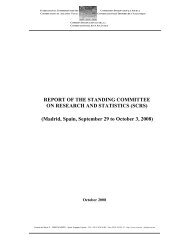E - Iccat
E - Iccat
E - Iccat
You also want an ePaper? Increase the reach of your titles
YUMPU automatically turns print PDFs into web optimized ePapers that Google loves.
PANEL 1<br />
It should be noted that projections indicate that future catches represent the total removals from the bigeye tuna<br />
stock, and not only the TAC of 85,000 t established by ICCAT. Catches made by other fleets not affected by the<br />
catch limits need to be added to the 85,000 t for comparison with future constant catch scenarios. Furthermore,<br />
all future changes in selectivity such as an increase in the relative mortality of small fish, will change and add to<br />
the uncertainty of these projections.<br />
The SCRS is concerned that the recommendation in force includes a fishing possibility scheme which allows<br />
exceeding the 85,000 t TAC. However, this situation has not yet occurred.<br />
The TAC was reduced in 2009 from 90,000 t to 85,000 t, and concern over the catch of small bigeye has led to<br />
the establishment of spatial closures in the gulf of Guinea. Proof of the effectiveness of these closures to reduce<br />
the fishing is not yet available to reduce the fishing mortality of juvenile bigeye tuna.<br />
The SCRS recommends a TAC of 85,000 t or less to achieve a high probability of maintaining stock levels<br />
consistent with the Convention objectives. Lastly, the Commission should be aware of the risk of exceeding the<br />
TAC (100,000 t).<br />
With regard to yellowfin tuna, the last assessment conducted in 2011, 10% of the world production is from the<br />
Atlantic. Historically, catches reached a peak of 194,000 t in 1990, followed by a decreasing trend, subsequent<br />
significant fluctuations with a general decreasing trend and finally a slight increase in recent years. There has<br />
been a generally declining trend in average weight for all gears combined, until recent years, largely due to shifts<br />
in purse seine effort from free schools to FAD associated schools. Average sizes of fish caught by EU purse<br />
seiners have declined to half of those recorded in 1990, which could partly be due to the changes in selectivity<br />
associated with FAD fishing since the 1990s. This change in selectivity affects the MSY.<br />
The yellowfin tuna stock was assessed in 2011. The Kobe matrix shows important uncertainties as regards the<br />
assessment of yellowfin tuna stock status and productivity. 26% of results are consistent with the Convention’s<br />
objectives. Maintaining the TAC at 110,000 t should lead to a biomass above the B MSY in 2016, with a 60%<br />
probability. The reported catches for 2011 are below the TAC (100,277 t). The estimates for biomass trends from<br />
ASPIC indicate a slow trend and continue to recover. The VPA estimates of SSB trend show a recent decline and<br />
corresponding increase in the fishing mortality of mature fish.<br />
In both cases, a continuous increase of catches would slow down the biomass recovery and would speed up the<br />
reduction in SSB. Longer temporary closures and wider areas than those included in the current regulation would<br />
have better effects (a closure between January 1 to February 28 foreseen in Rec. 11-01), if this moratorium is<br />
fully respected.<br />
The SCRS indicates that a level of yellowfin catches equal to or higher than 140,000 t would reduce the results<br />
to less than 50% of the Convention’s objectives, and as a result the SCRS continues to recommend efficient<br />
measures to reduce the mortality of juvenile yellowfin tuna under FADs, as well as other causes of mortality.<br />
Lastly, if the estimates of unreported catches for purse seiners were taken into account, the estimates of stock<br />
status and the projections would be even more pessimistic: it is thus imperative to implement control measures<br />
for the fleets concerned.<br />
The Chair then invited Dr. Santiago to present his recommendations on statistics. These concern the following:<br />
1) Assist Côte d’Ivoire in the development of a Task I and Task II database since 1985. This improvement in<br />
reporting will also be beneficial for Panel 4.<br />
2) An inter-sessional meeting focused on reviewing the objectives of the tropical Atlantic tagging<br />
programme.<br />
3) A skipjack assessment in 2014, in line with the recent catch increase, the expansion of purse seine<br />
towards new areas and the need to update information on biology and statistics.<br />
The responses to the Commission's requests are as follows:<br />
233

















